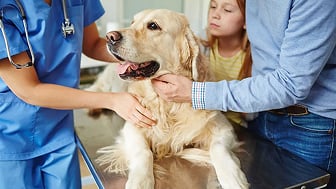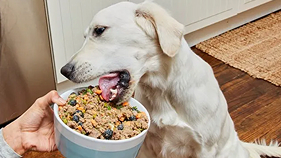Frequently asked questions about pet insurance
What does Healthy Paws cover?
Policies are underwritten and issued by ACE American Insurance Company, Westchester Fire Insurance Company, Indemnity Insurance Company of North America, ACE Property & Casualty Insurance Company, Atlantic Employers Insurance Company, members of the Chubb Group.
The Healthy Paws pet insurance plan covers the unexpected things that come up with pet health care, whether that is an accident or illness. If your pet gets sick or injured, the Healthy Paws plan can help, subject to the policy's terms and conditions. The pet insurance plan has no caps on payouts: no per-incident caps, no annual caps, and no lifetime caps.
If your pet shows signs or symptoms of a new accident or illness after enrollment and after any applicable waiting period, it will be eligible for coverage. The pet insurance plan covers medically necessary veterinary treatments, including but not limited to:
- Diagnostic testing such as x-rays and blood tests
- Hospitalization, including any treatments while in the hospital
- Surgeries
- Prescription medications
You may use any licensed veterinarian.
For CA, DE, LA, ME, MD, MS, NE, NH, OH, PA, WA, VT, MT:
A veterinarian is defined as a properly licensed and registered veterinarian in active practice in the area where the pet is treated or examined. Veterinarian shall not include you or a member of your immediate family.
For all states except those listed in the section below:
- There is a waiting period of 15 days after your policy effective date. Your policy is effective at 12:01 a.m. the day after you enroll your pet(s).
- You can submit claims for accidents and illnesses that occur after the 15-day waiting period.
- Hip Dysplasia: For pets enrolled at age five or below, there is a 12-month waiting period for hip dysplasia.
For CA, DE, LA, ME, MD, MS, NE, NH, OH, PA, WA, VT, MT:
- There is a 15-day waiting period from the pet policy effective date for illness, injury and orthopedic conditions (other than hip dysplasia) not resulting from an accident. (However, this waiting period will be waived by us upon completion of a complete clinical examination.)
- There is no waiting period for illness, injury or orthopedic conditions resulting from an accident.
- Hip Dysplasia: There is a 30-day waiting period from the pet policy effective date for hip dysplasia not resulting from an accident. (However, this waiting period will be waived by us upon completion of a complete clinical examination.)
With a Healthy Paws pet insurance plan, you will have continuous coverage for the life of the policy, without the concern of any type of per-incident, annual or lifetime caps.
Hereditary and congenital conditions are eligible for coverage so long as the signs and symptoms first manifest after enrolling, and after any applicable waiting periods.
Hereditary condition: An abnormality that is genetically transmitted from parent to offspring and may cause illness or disease. Some examples: Bladder Stones, Epilepsy, Heart Disease, Degenerative Myelopathy, Brachycephalic Syndrome, Hip Dysplasia
Congenital condition: A condition that is present from birth, whether inherited or caused by the environment, which may cause or contribute to illness or disease. Some examples: Cleft Palate, Umbilical Hernia, Inguinal Hernia, Limb Deformities
Hip dysplasia is included in the coverage at no additional cost to you as long as the following requirements are met:
- Your pet is under the age of six (6) at the time of enrollment
- No clinical signs or symptoms manifest within the first twelve (12) months from the Pet Policy Effective Date.
For CA, DE, LA, ME, MD, MS, NE, NH, OH, PA, WA, VT, MT:
Hip dysplasia is included in the coverage at no additional cost to you as long as the following requirements are met:
- Your pet is under the age of six (6) at the time of enrollment
- No clinical signs or symptoms manifest within the first 30 days from the pet policy effective date unless waived by us upon completion of a complete clinical examination.
Get a quote in seconds for care that shows up when it counts
What is not covered?
The most common exclusions encountered during the claims review process are:
- Wellness and preventative care (such as vaccinations or titer testing, spaying/neutering, flea/heart worm control medication, nail trims and grooming, parasite control/de-worming, annual fecal and heart worm testing)
- Examination fees
- Pre-existing conditions
- Conditions occurring within policy waiting period(s)
- Routine dental healthcare (such as cleanings)
- Behavioral treatment
- Non-FDA treatment or supplements
- Pet food/special pet diets
- Day care/boarding
Excluding routine costs like exam fees helps Healthy Paws keep the premiums for the policy more affordable.
Wellness and preventative care are not covered by the Healthy Paws policy. The plan is here for unexpected veterinary care.
Some examples of preventative care include:
- Vaccinations or titer testing
- Spaying/neutering
- Flea/heart worm control medication
- Nail trims and grooming
- Parasite control/de-worming
- Routine dental care, including dental cleanings
- Annual fecal and heart worm testing
The pet insurance plan offers coverage for dental care related to traumatic injury, such as chipping a tooth. If injury to teeth is caused by an accident, we do cover the cost of extraction and/or reconstruction of damaged teeth.
Treatment for dental illnesses is also eligible for coverage, as long as there were no signs or symptoms of the condition prior to enrollment or during any applicable waiting period.
As fellow pet parents, we understand this can be one of the hardest parts of pet ownership. The Healthy Paws plan can cover the costs of euthanasia when it is medically necessary for a covered condition. Expenses for aftercare, such as cremation or burial, are not eligible for coverage.
Pre-Existing Conditions
A pre-existing condition means: An Illness or condition which developed or redeveloped prior to the pet policy effective date or an injury, or recurrence of an injury, as a result of an accident that occurred prior to the pet policy effective date; or any condition or complication resulting from an illness that developed, or any injury as a result of an accident that occurred prior to the pet policy effective date.
The Healthy Paws plan helps protect your pet against accidents and illnesses that may occur after any applicable waiting period(s).
For CA, DE, LA, ME, MD, MS, NE, NH, OH, PA, WA, VT, MT:
Be sure to see the State Amendatory Statement for your state’s specific definition of “pre-existing condition.”
If you are aware that your pet has a congenital condition before you enroll in pet insurance, this condition would be considered pre-existing.
There are many types of congenital conditions that do not become apparent until sometime after birth. Healthy Paws will cover these types of congenital conditions as long as there were no clinical signs or symptoms present before enrollment or during any applicable waiting periods.
If your pet's complete medical records review shows no history of a cruciate ligament problem, and no history of limping, the injury is eligible for coverage.
However, if your pet has shown lameness, or a full/partial tear before enrollment or during any applicable waiting period as defined above, on either side prior to enrollment, the other side is also excluded from coverage. The cruciate ligament is the only bilateral exclusion in the policy. (Bilateral: having or relating to two sides; affecting both sides.)
Eligibility & Requirements
All pets should have undergone a veterinary examination to speed up processing your claims. Your pet’s age at enrollment determines when your pet should have/had the exam.
- For pets 5 years old and under: an exam must have taken place within 12 months prior to enrollment (or within 15 days after the pet policy effective date.)
- For pets 6 years old and over: an exam must have taken place within 30 days prior to enrollment (or 15 days after the pet policy effective date.)
- No additional diagnostic testing such as x-rays or blood work is required.
When you file your first claim, we will need a copy of your pet's full medical history. You may upload a copy of your pet's most recent exam records in the Customer Center. Medical records for your pet include doctor's notes (sometimes referred to as “SOAP Notes,” which is a standardized format used by veterinarians to document patient medical records), laboratory results, and other documentation regarding all of your pet's visits to the veterinarian.
Your veterinarian may also submit these records by emailing them to records@healthypawspetinsurance.com or faxing to 844-333-0739.
For CA, DE, LA, ME, MD, MS, NE, NH, OH, PA, WA, VT, MT:
A veterinary examination is not required, but your pet should have one to ensure the ease and speed of claims processing. You may upload a copy of your pet's most recent exam records in the Customer Center.
You may use the rescue group's or shelter's adoption physical exam if you have documentation, including the doctor's notes (sometimes referred to as “SOAP Notes,” which is a standardized format used by veterinarians to document patient medical records). You can upload a copy of the exam records in the Customer Center. If you are uncertain that the adoption records satisfy the exam requirements, it is recommended your pet receives an exam from a veterinarian.
For CA, DE, LA, ME, MD, MS, NE, NH, OH, PA, WA, VT, MT:
A veterinary examination is not required, but your pet should have one to ensure the ease and speed of claims processing. You may upload a copy of your pet's most recent exam records in the Customer Center.
Sit, stay, get covered. Get a quick quote for premium, affordable pet insurance.
Filing Claims
You can expect:
- You have the option to choose any licensed veterinarian. This includes specialists and emergency animal hospitals.
- After paying for the treatment in full, submit a copy of your paid invoice to Healthy Paws for review.
While you're helping your pet get better, we'll work on getting your claim processed.
No forms are necessary! You can simply submit your claim by taking a photo of your invoice and uploading it through our online Customer Center or Healthy Paws Mobile App.
The claim must be submitted within 90 days of the invoice date.
- You can also submit your invoice(s) and supporting medical documents to claims@healthypawspetinsurance.com
- Fax (888)-228-4129
- Or mail to:
Healthy Paws Pet Insurance
P.O. Box 1156
Portland, ME 04104
Yes! To meet your annual deductible (after which reimbursements will start), we recommend that you submit all claims pertaining to new accidents, illnesses and injuries.
Getting Reimbursed
Reimbursements are based on your actual veterinary bills. Claims representatives determine the total of the covered treatments, and reimburse you for the percentage of those bills that you selected for your policy, minus your remaining annual deductible.
For example:
Say you have a policy with a $250.00 annual deductible and a reimbursement rate of 80%
- You get a vet bill for $1,200 in covered treatments
- 80% of $1,200 = $960
- $960 minus your $250 annual deductible = $710
- You are reimbursed $710 for that $1,200 bill
For your next bill, you would be reimbursed a full 80% for covered treatments. (Your pet's deductible is annual, meaning it must be satisfied only once per policy term and resets on the anniversary of your pet's enrollment.)
If a claim is approved, any reimbursement due will be issued on average within 1 business day. You can choose to be reimbursed via a mailed check or direct deposit (you can enroll for this in the Customer Center.)
- Reimbursement via a mailed check can take up to 15 days to reach you, depending on your location.
- Reimbursement via direct deposit may take up to 72 hours to process depending on your bank or financial institution.
In situations where you cannot pay your vet at the time of treatment, you may contact us to request payment directly to your vet in the event of a covered claim. You must make your request for direct payment in advance of the treatment to allow our claims team time to coordinate direct payment. Approval for direct payment does not mean a claim will be covered, and you will remain responsible for all amounts due.
In the event of approval on a covered claim, if your veterinary hospital is willing to accept direct payment, we can work with them to expedite access to your pet's medical records and the processing of your claim. This direct payment option is available for any licensed vet across the United States; it is not limited to any specific network of vets.
Direct payment on covered claims is available during business hours. Please call (855) 898-8991 and select the option to speak with a Claims Representative.
Managing your Poilcy
Congratulations on a new addition to the family!
You can use the Add a Pet feature in the Customer Center to add your new pet to your policy.
Your annual deductible is the amount you’ll pay out-of-pocket each year before your plan begins to cover medical costs for your pet(s). The annual deductible is by "coverage term." For example, if your policy became effective on May 25, 2022, your coverage term would last through May 24, 2023.
To meet your annual deductible (and begin getting reimbursed), make sure to submit all claims pertaining to accidents, illnesses and injuries.
Yes, you can change your Policy Options in the Customer Center.
You can lower your deductible and raise your reimbursement level as long as you have not submitted any claims. This would result in lower out-of-pocket expenses and a higher reimbursement, and correspondingly, a higher monthly premium.
If you have submitted any claims, you will only be able to lower your reimbursement and raise your deductible.
You can view your reimbursement and deductible options by clicking Pet Policies in the Customer Center to change your policy options, subject to the policy terms and conditions.
Note: lowering your reimbursement level and/or raising your deductible are both ways to reduce the cost of your monthly premiums.
Billing
To update your profile or billing information, please sign in to the Healthy Paws Customer Center.
Your monthly premium will be charged automatically to your credit or debit card or bank account each month on the same date that you enrolled. For example, if you enrolled on the 15th of the month, all payments moving forward will be deducted from the card on file on the 15th of each month.
For Pet Parents that enroll on or during the 28th to 31st of the month, the billing date defaults to the 28th because of February.
We currently accept any debit or credit cards issued by VISA, MasterCard, American Express, and Discover or you can pay via bank account (ACH). Choosing to pay via bank account lets you avoid credit card processing fees. You can change your payment method at any time by logging into the Customer Center.
Premiums are determined based on the rates and rating rules filed with and approved by (as applicable), each state's insurance regulator, which reflect the cost of treatment advances in veterinary medicine, individual pet's breed, gender, age, and other factors, in addition to the overall claims experience for the program within the region where the pet resides.
Premium increases are not based on your individual claim submissions.
We'd sure be sorry to see you go, but if you still want to cancel your policy, you can let us know via regular mail, fax, email or verbally. Learn more about canceling your Healthy Paws plan here.



